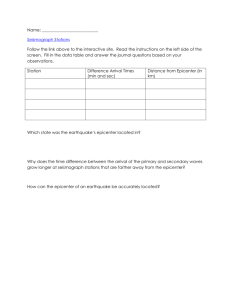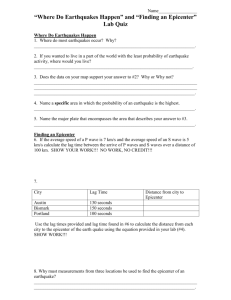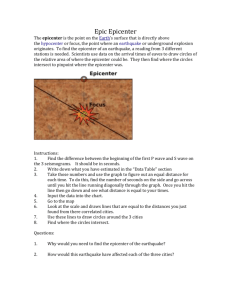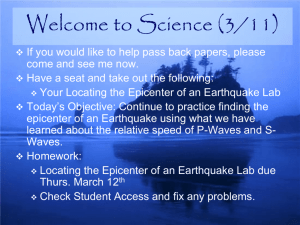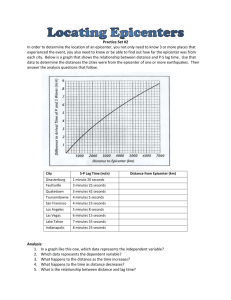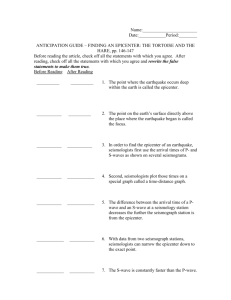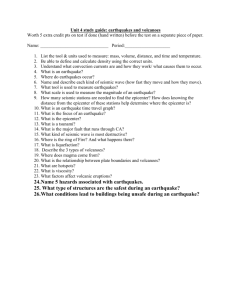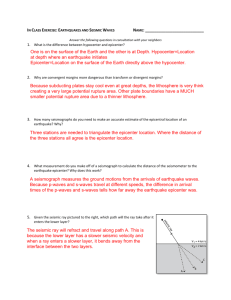ITEST Project Briefing - Center on Education and Work
advertisement
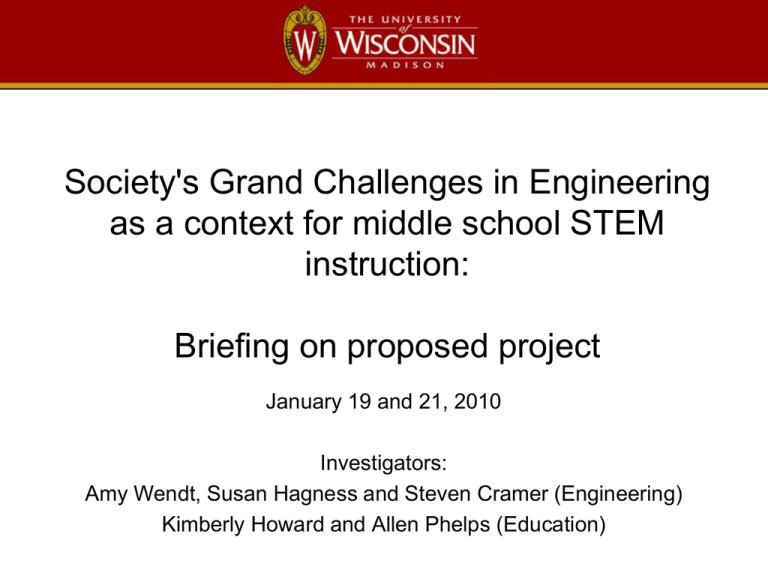
Society's Grand Challenges in Engineering as a context for middle school STEM instruction: Briefing on proposed project January 19 and 21, 2010 Investigators: Amy Wendt, Susan Hagness and Steven Cramer (Engineering) Kimberly Howard and Allen Phelps (Education) NSF ITEST Program • The National Science Foundation is seeking solutions to “help ensure the depth and breadth of the STEM workforce.” ITEST: Innovative Technology Experiences for Students and Teachers STEM: science, technology, engineering and math • Program solicitation link • NSF proposal deadline: early February • Letters of support from participating schools needed by Feb. 1 • Project duration: 3 years our proposed dates: 9/1/2010-8/31/2013 2 UW ITEST proposal • Project goal: create interest in engineering among a larger and more diverse population of middle school students • Strategy: Introduce grand challenges in engineering (GCE) in math and science instruction Create a school-based GCE community of teachers & counselors to: Develop, implement and evaluate GCE instructional resources Increase awareness of grand-challenge related careers that utilize math and science skills Collect and use data to: evaluate: • classroom implementation of instructional materials • changes in student perceptions about engineering and its relation to personal goals improve/expand instructional resources 3 Motivation: Diversity in Engineering • Source: American Society of Engineering Educators, 2008 • Down from 19.5% in 2005 and 21.2% in 1999 • Compared to ~ 50% in biological sciences 4 Diversity in Engineering 5 Diversity in Engineering • Women’s Experiences in College Engineering Project Survey of ~25,000 undergraduate women in engineering programs at 53 institutions,1999-2001 A top reason why women enter engineering: attraction to the altruistic kind of work engineers do Critical factor in retention: exposing women early on to how engineering has led to improvements in society and the quality of people’s lives “Final Report of the Women’s Experiences in College Engineering (WECE) Project,” Goodman Research Group, Inc., Cambridge, MA, April 2002. 6 Grand Challenges in Engineering http://www.engineeringchallenges.org/ Sustainability • Make solar power economical • Provide energy from fusion • Develop carbon sequestration methods • Manage the nitrogen cycle • Provide access to clean water • Restore and improve urban infrastructure Vulnerability • Prevent nuclear terror • Secure cyberspace Health • Advance health informatics • Engineer better medicine • Reverse-engineer the brain Joy of Living • Enhance virtual reality • Advance personalized learning • Engineer the tools of scientific discovery 7 Background: New GCE course at UW • InterEgr 102: Cross-disciplinary approach to first-year engineering education Builds on NAE themes Highlights opportunities to positively shape the world’s future • Case studies format: Modules prepared by both instructors and students Based on existing literature – news articles, government reports and research journals Wide range of presentation topics Students: Write written reports Prepare/deliver • Oral presentations • Poster presentations 8 GCE at UW: course for 1st year students Theme 1: Engineering challenges on a personal scale Diagnosis/treatment of disease, assistive technologies, rehab engineering, biometrics, … Theme 2: Engineering the Wisconsin Idea Energy, regional eco-systems, transportation, security, … Theme 3: Engineering for developing communities Water, housing, health care, lighting, energy, information, … Theme 4: Engineering the megacity Pollution, transportation, energy, natural disasters, security, … Theme 5: Global engineering challenges Energy, terrorism, biodiversity, pandemics, climate change, … Theme 6: Engineering beyond planet Earth Space travel, inhabiting space, near-earth objects, extraterrestrial 9 communication, … GCE at UW: example course content Topic: early detection/warning to prevent earthquake damage • Seismometers commonly used to locate the epicenter after the quake has occurred • How? Exploit differences between P and S waves1 Nondestructive P (primary) wave speed: 6-7 km/s Destructive S (secondary) wave speed: 3-4 km/s • Interactive illustrations on National Geographic web site: http://www.nationalgeographic.com/forcesofnature/interactive/index.html?section=e Locate an earthquake – Lab 6 • Let’s try it ourselves! 10 Snapshot from GCE case study Determining location of earthquake epicenter • Seismometers commonly used to locate the epicenter after the quake has occurred • Example: 3 stations record seismic activity Where is the epicenter? B 60 km tp=20 s ts=50 s C tp=10 s ts=30 s A P wave speed: 6 km/s S wave speed: 3 km/s tp=0 ts=10 s 11 Snapshot from GCE case study Determining location of earthquake epicenter • Seismometers commonly used to locate the epicenter after the quake has occurred • Example: 3 stations record seismic activity Where is the epicenter? B 60 km C A How far away? P wave speed: 6 km/s S wave speed: 3 km/s 12 Snapshot from GCE case study Determining location of earthquake epicenter • Seismometers commonly used to locate the epicenter after the quake has occurred • Example: 3 stations record seismic activity Where is the epicenter? B 60 km C A 60 km P wave speed: 6 km/s S wave speed: 3 km/s 13 Snapshot from GCE case study Determining location of earthquake epicenter • Seismometers commonly used to locate the epicenter after the quake has occurred • Example: 3 stations record seismic activity Where is the epicenter? How far away? B 60 km C A P wave speed: 6 km/s S wave speed: 3 km/s 14 Snapshot from GCE case study Determining location of earthquake epicenter • Seismometers commonly used to locate the epicenter after the quake has occurred • Example: 3 stations record seismic activity Where is the epicenter? 120 km B 60 km C A P wave speed: 6 km/s S wave speed: 3 km/s 15 Snapshot from GCE case study Determining location of earthquake epicenter • Seismometers commonly used to locate the epicenter after the quake has occurred • Example: 3 stations record seismic activity Where is the epicenter? B How far away? 60 km C A P wave speed: 6 km/s S wave speed: 3 km/s 16 Snapshot from GCE case study Determining location of earthquake epicenter • Seismometers commonly used to locate the epicenter after the quake has occurred • Example: 3 stations record seismic activity Where is the epicenter? 180 km 60 km B C A P wave speed: 6 km/s S wave speed: 3 km/s 17 Snapshot from GCE case study Determining location of earthquake epicenter • Seismometers commonly used to locate the epicenter after the quake has occurred • Example: 3 stations record seismic activity Where is the epicenter? B 60 km C A epicenter P wave speed: 6 km/s S wave speed: 3 km/s 18 Alignment with instructional standards • This instructional task (determining the location of the earthquake epicenter) directly aligns with “Mathematical Practice” standards that are being proposed for the State Common Core Standards in math. • See: http://www.corestandards.org/Standards/index.htm • Quoting the proposed Mathematics Practice standard: Proficient students expect mathematics to make sense. They take an active stance in solving mathematical problems. When faced with a nonroutine problem, they have the courage to plunge in and try something, and they have the procedural and conceptual tools to carry through. They are experimenters and inventors, and can adapt known strategies to new problems. They think strategically. • More specifically, this task requires or could be developed in ways that students are required to demonstrate the following standards: Construct viable arguments Make sense of complex problems Look for and make use of structure 19 Impact of GCE course at UW • Higher % female representation than other UW “Introduction to Engineering” courses UW GCE course Other engineering intro. courses 20 Society’s Grand Challenges in Engineering as a Context for Middle School Instruction in STEM Proposal in preparation for submission to the NSF ITEST program UW team members • • • • • Amy Wendt, Electrical and Computer Engineering Susan Hagness, Electrical and Computer Engineering Steven Cramer, Civil and Environmental Engineering Kimberly Howard, Counseling Psychology Allen Phelps, Education Leadership 22 UW ITEST proposal • Project goal: create interest in engineering among a larger and more diverse population of middle school students • Strategy: Introduce grand challenges in engineering (GCE) in math and science instruction Create a school-based GCE community of teachers & counselors to: Develop, implement and evaluate GCE instructional resources Increase awareness of grand-challenge related careers that utilize math and science skills Collect and use data to: evaluate: • classroom implementation of instructional materials • changes in teacher/student perceptions about engineering, and its relation to student personal goals improve/expand instructional resources 23 Current status 24 Goal: GCE awareness through multiple channels • Heighten awareness of GCE throughout the school: Teachers Counselors Peers • Shape students’ sense that STEM careers are possible & interesting for them Messages guided by Social Cognitive Career Theory (SCCT): Self efficacy: belief that one possesses the capability to perform STEM-related activities Outcomes expectations: engaging in STEM-related activities advances one’s personal goals 25 Social Cognitive Career Theory 26 Innovation and Research Network 27 GCE Implementation: instructional pilot • Pilot GCE module will provide alternative, context-rich approaches to teaching core content • GCE module duration: 1-3 weeks • GCE module will include instructional materials that: Address state/regional standards for the topic GCE material will complement instructional content to create a “story line” for the content • Before/after student questionnaire on perceptions about engineering 28 Pilot GCE module development • UW participants will research GCE topics for inclusion in pilot module • UW and Madison area school participants will develop instructional activities to complement GCE material – academic year 2010-2011 • Summer Institute 2011: All participants gather on UW-Madison campus for one week UW participants will provide overviews of: Grand Challenges in Engineering Social Cognitive Career Theory GCE middle school pilot module status All will discuss, refine, modify and improve pilot module Middle school educators will finalize module curriculum and implementation plan for their schools 29 Timeline Academic year Fall Semester Spring Semester Summer 2010-2011 Assemble GCE content; work with local schools on instructional content Development continues Summer Institute; Finalize pilot module(s) 2011-2012 Implement pilot; Implementation, Evaluate; Develop development and additional module(s) evaluation continue Summer Institute; Evaluation and module revision/development 2012-2013 Implement modules; Implementation and Evaluate evaluation continue Evaluation completed; Final report 30 How to participate? • Commit a team of 3-5 educators from your school – participation from summer 2011 to the end of the 2011-2012 academic year • Local schools may also participate in GCE module development during the 2010-2011 academic year • Travel expenses – stipend and travel expenses provided for Summer Institute participation • We request letters of commitment to be included in our proposal to NSF Use school letterhead Submit to Prof. Amy Wendt by Monday, Feb. 1 Email pdf copy to wendt@engr.wisc.edu Or fax to 608-262-1267 31 Summary (& input for letter of commitment) • UW-Madison proposal entitled “Society’s Grand Challenges in Engineering as a Context for Middle School Instruction in STEM” • To be submitted to NSF ITEST program – 3 year project • Goal: attract and retain a more diverse pool of students, particularly women, into the technology workforce • Motivation: studies showing an attraction among female students to the kind of altruistic work engineers do • Strategy: develop curriculum-specific grand challenges instructional modules appropriate for middle school teacher/counselor training to support classroom use of these materials Evaluate changes in teacher/student perceptions about engineering, and its relation to student personal goals • Instructional materials will be modeled after the "Grand Challenges" curriculum currently in use at the UW Madison College of Engineering school teams (3-5 participants/school) will contribute to module development at working Summer Institutes at UW-Madison in 2011 and 2012 will be piloted in schools during 2011-12 and 2012-13 school years 32
